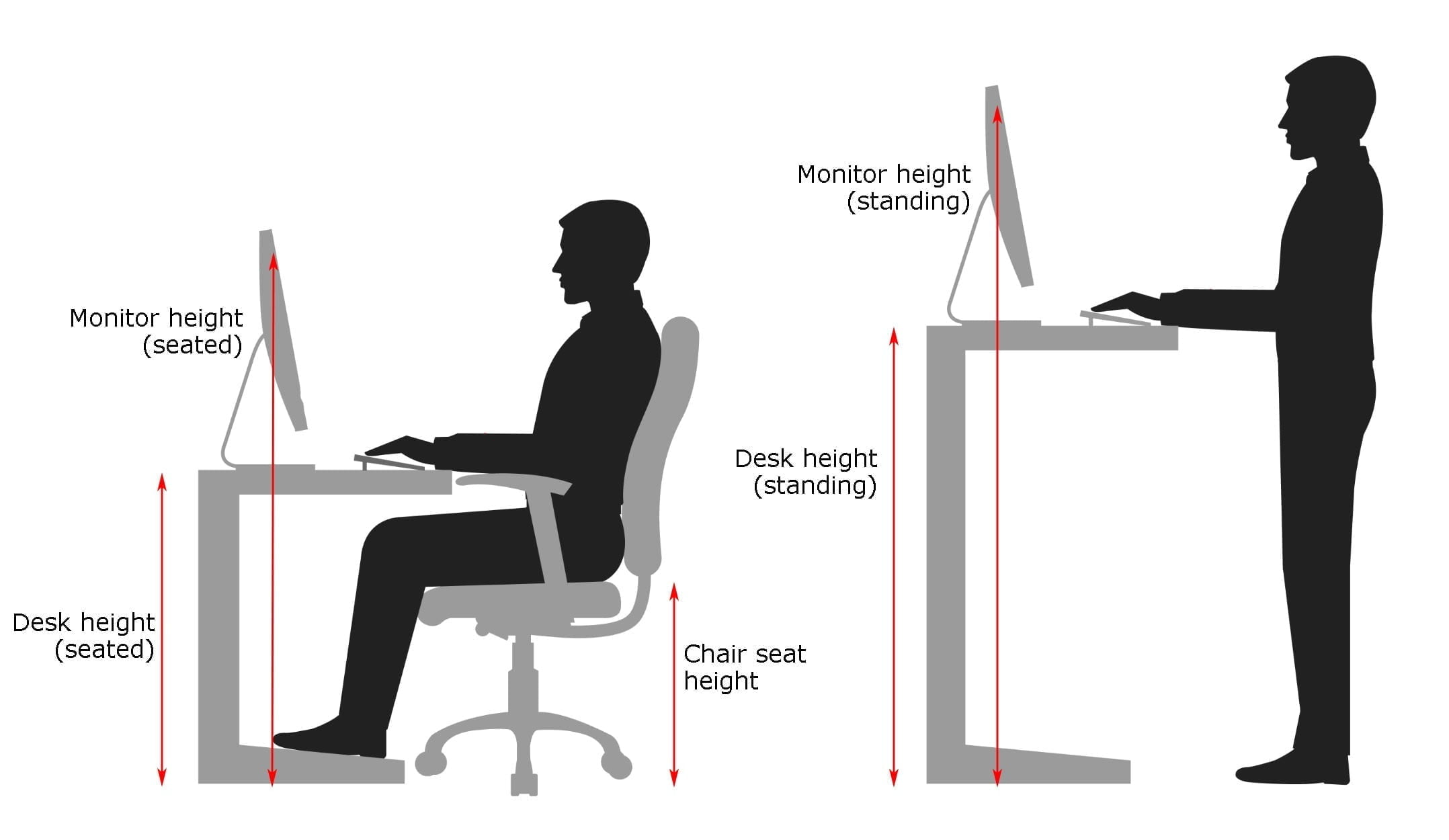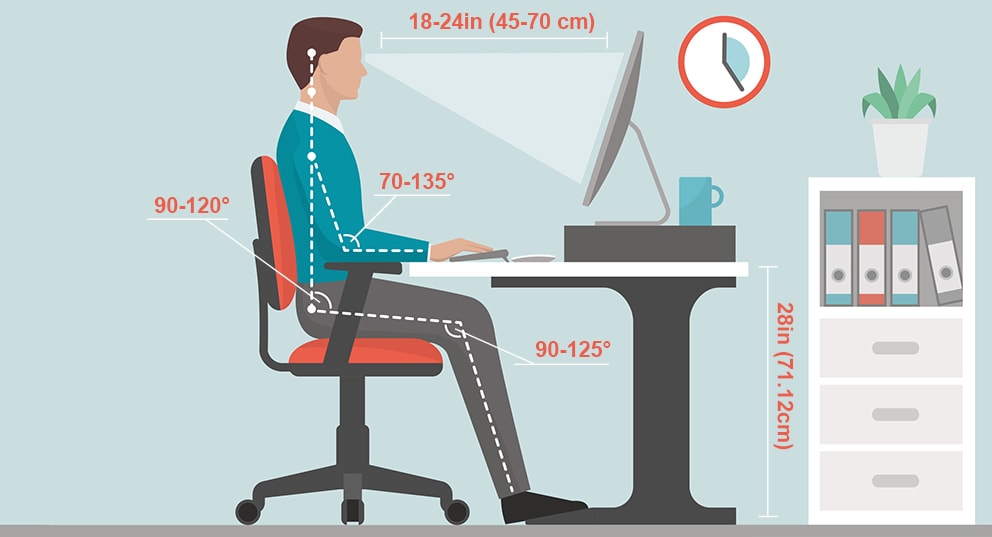Ergonomic Considerations: How High Should A Desk Chair Be

Sitting at a desk for extended periods can take a toll on your body, but having the right desk chair height can make a world of difference. It’s all about finding that sweet spot to keep your body happy and healthy.
Lower Back Support
The right desk chair height is crucial for supporting your lower back. When your chair is too low, you’re forced to slouch, putting extra strain on your lumbar region. On the other hand, a chair that’s too high can cause you to lean forward, leading to similar discomfort. A properly adjusted chair ensures your back rests comfortably against the backrest, promoting good posture and minimizing strain.
Shoulder and Neck Posture
Your chair height directly impacts your shoulder and neck alignment. When your chair is too low, you might hunch over, straining your neck and shoulders. Conversely, a chair that’s too high can lead to you tilting your head back, also causing discomfort. The ideal chair height allows you to keep your shoulders relaxed and your head in a neutral position, preventing strain and pain.
Leg Circulation
Chair height also plays a role in leg circulation. If your chair is too low, your legs might be bent at an awkward angle, hindering blood flow and potentially leading to discomfort or even swelling. Conversely, a chair that’s too high can put pressure on the backs of your thighs, again affecting circulation. The ideal height allows for your feet to rest flat on the floor, promoting healthy blood flow and preventing circulation issues.
Tips for Adjusting Chair Height
Here are some tips to help you find the perfect chair height:
- Sit upright with your feet flat on the floor. Your thighs should be parallel to the floor, and your knees should be slightly bent.
- Make sure your back rests comfortably against the backrest.
- Adjust your chair height until you achieve a comfortable and neutral posture.
- Take breaks and stand up regularly to promote blood flow and prevent stiffness.
Determining the Ideal Desk Chair Height

Finding the right desk chair height is crucial for achieving optimal comfort and ergonomics. An improperly adjusted chair can lead to discomfort, pain, and even long-term health issues. Here’s a comprehensive guide to help you determine the perfect desk chair height for your specific needs.
Desk Height’s Influence on Chair Height
The height of your desk significantly impacts the ideal chair height. A desk that’s too high will force you to hunch over, straining your neck and shoulders. Conversely, a desk that’s too low will require you to slouch, putting pressure on your lower back.
Individual Height’s Impact on Chair Height
Your individual height plays a crucial role in determining the right chair height. Taller individuals will generally need a higher chair to achieve a comfortable posture.
Thigh Length’s Role in Determining Chair Height
Thigh length is a key factor in chair height selection. When seated, your thighs should be parallel to the floor, with your knees slightly bent. This ensures proper blood circulation and reduces pressure on your legs.
Recommended Desk and Chair Heights
The following table provides a general guideline for recommended desk and chair heights based on common desk heights:
| Desk Height (inches) | Recommended Chair Height (inches) |
|—|—|
| 28 | 17-19 |
| 29 | 18-20 |
| 30 | 19-21 |
| 31 | 20-22 |
Note: These are just general recommendations. It’s essential to consider your individual height, thigh length, and personal preferences when determining the ideal chair height.
Desk Chair Height Adjustments

Desk chair height adjustments are a critical aspect of ergonomics, ensuring that your chair can be customized to fit your body and work style. The right chair height promotes proper posture, reduces strain on your back, neck, and wrists, and enhances your overall comfort. This section explores the different types of chair height adjustment mechanisms, their advantages and disadvantages, and how to optimize your chair height for various tasks.
Types of Chair Height Adjustment Mechanisms, How high should a desk chair be
Different types of chair height adjustment mechanisms are available, each offering its own advantages and disadvantages. The most common types are:
- Lever-operated mechanisms: These are the most common type of adjustment mechanisms, featuring a lever located beneath the seat. Pushing or pulling the lever raises or lowers the chair. Lever-operated mechanisms are typically simple to use and offer a wide range of adjustment. However, they can be noisy, and the lever can sometimes get in the way, especially if you have limited legroom.
- Gas lift mechanisms: Gas lift mechanisms use a pneumatic cylinder to adjust the chair height. They are smooth and silent, offering a quick and easy way to adjust the chair height. They are also typically more durable than lever-operated mechanisms. However, gas lift mechanisms can be more expensive than lever-operated mechanisms and can sometimes leak, requiring replacement.
- Manual screw mechanisms: These mechanisms use a screw to adjust the chair height. They are usually found on older chairs and are generally less expensive than other types of mechanisms. However, they are also less convenient to use, requiring more effort to adjust the chair height.
Pros and Cons of Each Adjustment Mechanism
The table below summarizes the pros and cons of each type of chair height adjustment mechanism:
| Mechanism | Pros | Cons |
|---|---|---|
| Lever-operated | Simple to use, wide range of adjustment, affordable | Can be noisy, lever can get in the way |
| Gas lift | Smooth and silent, quick and easy adjustment, durable | More expensive, can leak |
| Manual screw | Affordable, durable | Less convenient to use, requires more effort |
Adjusting Chair Height for Different Tasks and Activities
Optimizing your chair height for different tasks and activities is crucial for maintaining proper posture and reducing strain. Here are some tips:
- For typing and computer work: Adjust your chair height so your elbows are bent at a 90-degree angle and your forearms are parallel to the floor. Your wrists should be straight and relaxed, and your feet should be flat on the floor.
- For writing: Lower your chair slightly to ensure your shoulders are relaxed and your forearms are parallel to the desk surface.
- For reading: Adjust your chair height so you can comfortably hold the book at eye level. Your shoulders should be relaxed, and your back should be supported.
- For meetings: Adjust your chair height so your legs are comfortably bent at a 90-degree angle and your feet are flat on the floor.
Troubleshooting Common Desk Chair Height Adjustment Problems
Desk chair height adjustment mechanisms can sometimes malfunction, causing problems with adjusting the chair height. Here are some common problems and solutions:
- Chair not moving: This can be caused by a stuck lever, a faulty gas lift, or a worn-out screw. Check the lever for any obstructions, try pressing the lever firmly, or contact a chair repair specialist if necessary.
- Chair moving too slowly: This can be caused by a leaking gas lift. Contact a chair repair specialist for a replacement gas lift.
- Chair moving too quickly: This can be caused by a damaged gas lift. Contact a chair repair specialist for a replacement gas lift.
- Chair making a noise: This can be caused by a worn-out lever or a loose screw. Check the lever for any wear and tear, tighten any loose screws, or contact a chair repair specialist if necessary.
How high should a desk chair be – The height of your desk chair is crucial for maintaining proper posture and preventing discomfort. While a standard chair height might suffice for some, if you crave a more luxurious experience, consider investing in a large comfy desk chair.
These chairs often have adjustable heights, allowing you to fine-tune the position for optimal comfort and support, ensuring your back and neck are properly aligned regardless of your desk’s height.
The ideal height of a desk chair depends on your individual needs and preferences, but a good starting point is to ensure your feet are flat on the floor and your knees are bent at a 90-degree angle. If you’re looking for a student desk chair, consider checking out the range available at Officeworks, student desk chair officeworks , where you can find a variety of options to suit your budget and style.
Remember, the right chair can make a world of difference in your posture and overall comfort, so take the time to find one that fits you perfectly.